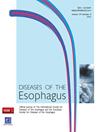788. LAPAROSCOPIC TOUPET FUNDOPLICATION - PERSONAL EXPERIENCE 174 CASES REPORT
IF 2.3
3区 医学
Q3 GASTROENTEROLOGY & HEPATOLOGY
引用次数: 0
Abstract
Background Gastroesophageal Reflux Disease (GERD) is one of the most important disorders of the gastrointestinal system, affecting 20% t o 40% of the population of the United States of America, and 12% on the world. There are several surgical techniques for treating this disease, including the Toupet Fundoplication technique, which reduce the postoperative complications, like dysphagia, Gas Bloating Syndrome and incapacity to belch. Methods Prospective cohort study with 174 patients in two hospitals, one public and the other private, in the city of Natal, Brazil. All patients were evaluated postoperative as the following: 1) first week after the surgery were interviewed by the master surgeon; 2) fifty days after surgery were submitted to a Barium Swallow; 3) three months after the surgery the endoscopy was performed. The follow-up was carried out in relation to the symptom of postoperative dysphagia, ability to belch, feeling of fullness and gastroesophageal reflux. Results A total of 174 patients were observed, who were submitted for the Toupet Fundoplication procedure. Of this total, 145 patients were followed-up. 143 patients had improvement of symptoms related to esophageal disease and are clinically satisfied. One patients had recurrence of reflux symptoms. One patient had Gas Bloating Syndrome. Conclusion Toupet Fundoplication was a standard procedure in the study and achieved good results in 98,62% of the cases followed during follow-up of GERD control and relief symptoms with a minimal rate of adverse effects in the postoperative period.788.腹腔镜胃底折叠术--个人经验 174 例报告
背景 胃食管反流病(GERD)是胃肠道系统最重要的疾病之一,影响着美国 20% 至 40% 的人口和全球 12% 的人口。目前有几种治疗这种疾病的手术技术,包括图佩特胃底折叠术,它可以减少术后并发症,如吞咽困难、胃胀综合征和无法嗳气。方法 对巴西纳塔尔市两家公立和私立医院的 174 名患者进行前瞻性队列研究。所有患者的术后评估如下:1)手术后第一周接受主刀医生的访谈;2)手术后 50 天接受吞钡术;3)手术后三个月接受内窥镜检查。对术后吞咽困难症状、嗳气能力、饱胀感和胃食管反流进行随访。结果 共观察了 174 名接受图佩特胃底折叠术的患者。其中 145 名患者接受了随访。143 名患者的食管疾病症状得到了改善,临床效果令人满意。一名患者反流症状复发。一名患者出现气胀综合征。结论 图佩特胃底折叠术是该研究中的标准手术,在随访的胃食管反流控制和症状缓解病例中,98.62% 的病例取得了良好的效果,术后不良反应率极低。
本文章由计算机程序翻译,如有差异,请以英文原文为准。
求助全文
约1分钟内获得全文
求助全文
来源期刊

Diseases of the Esophagus
医学-胃肠肝病学
CiteScore
5.30
自引率
7.70%
发文量
568
审稿时长
6 months
期刊介绍:
Diseases of the Esophagus covers all aspects of the esophagus - etiology, investigation and diagnosis, and both medical and surgical treatment.
 求助内容:
求助内容: 应助结果提醒方式:
应助结果提醒方式:


